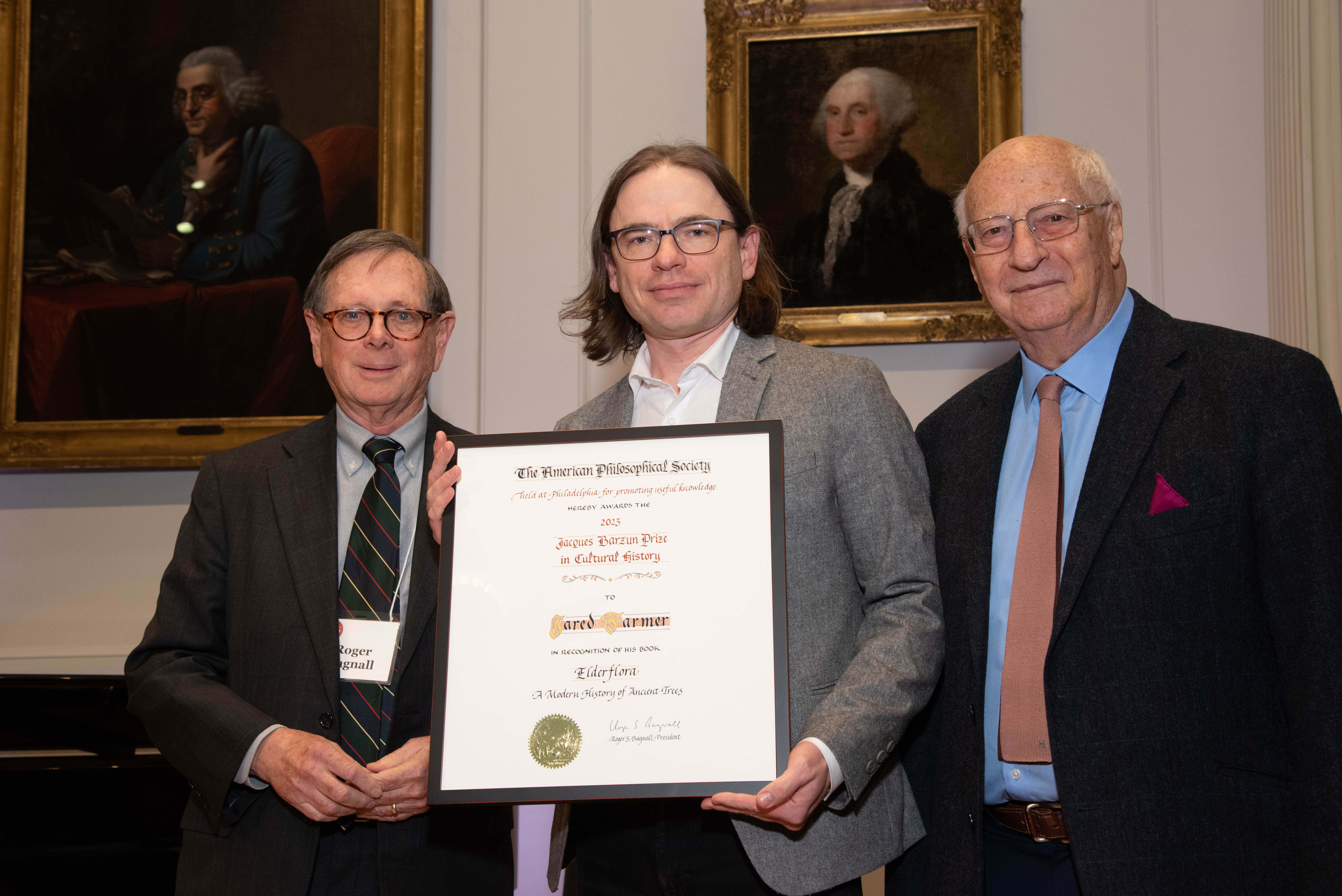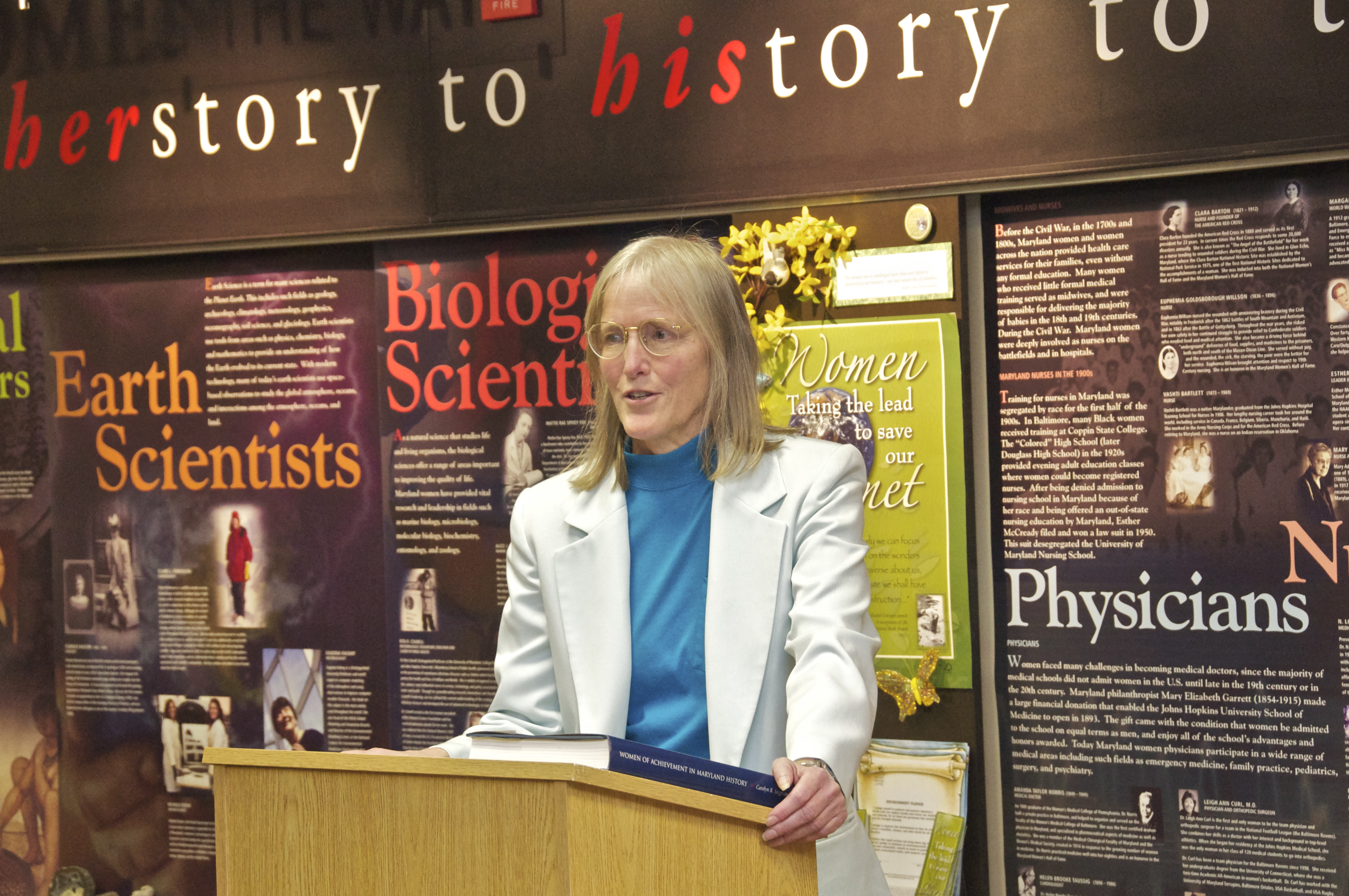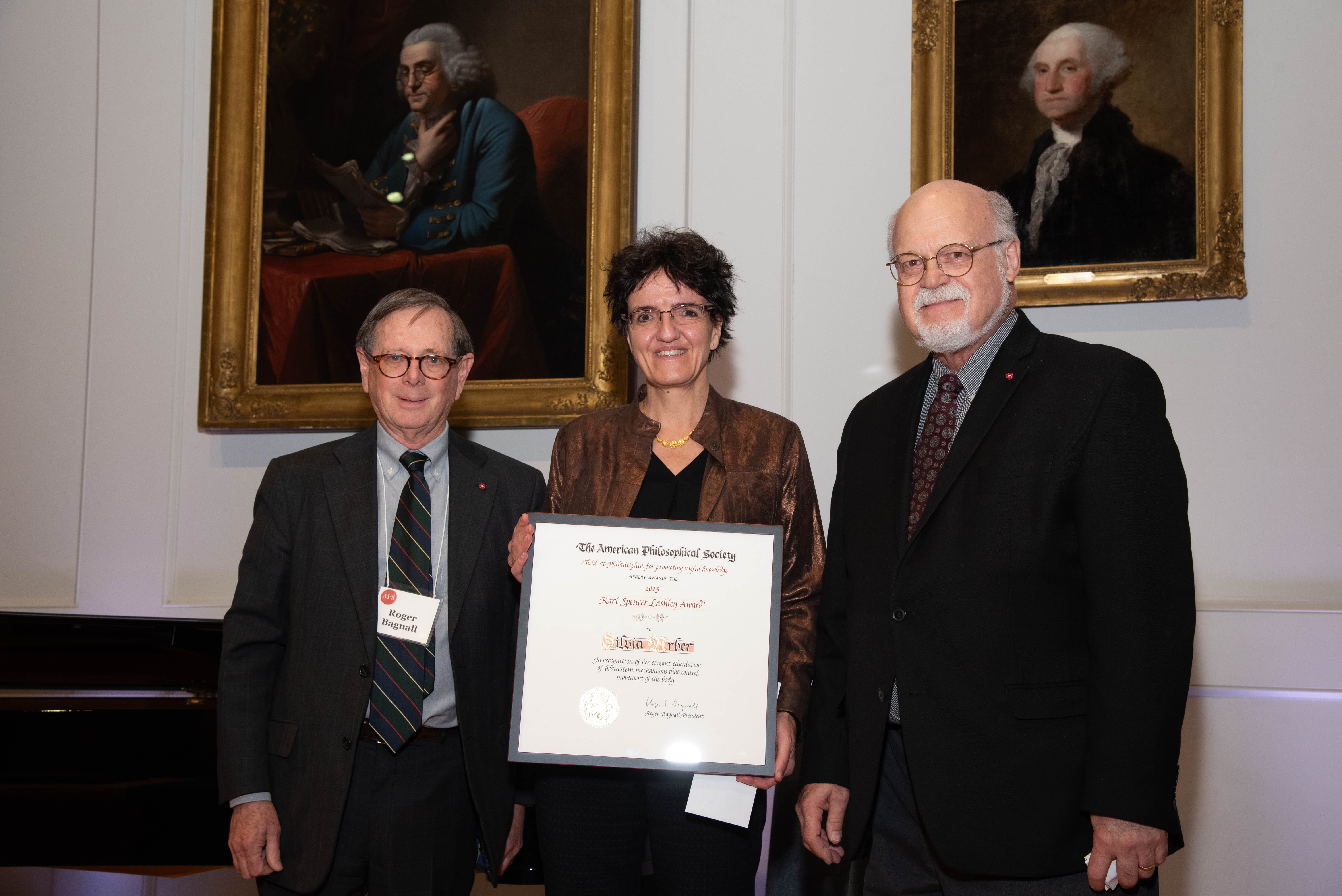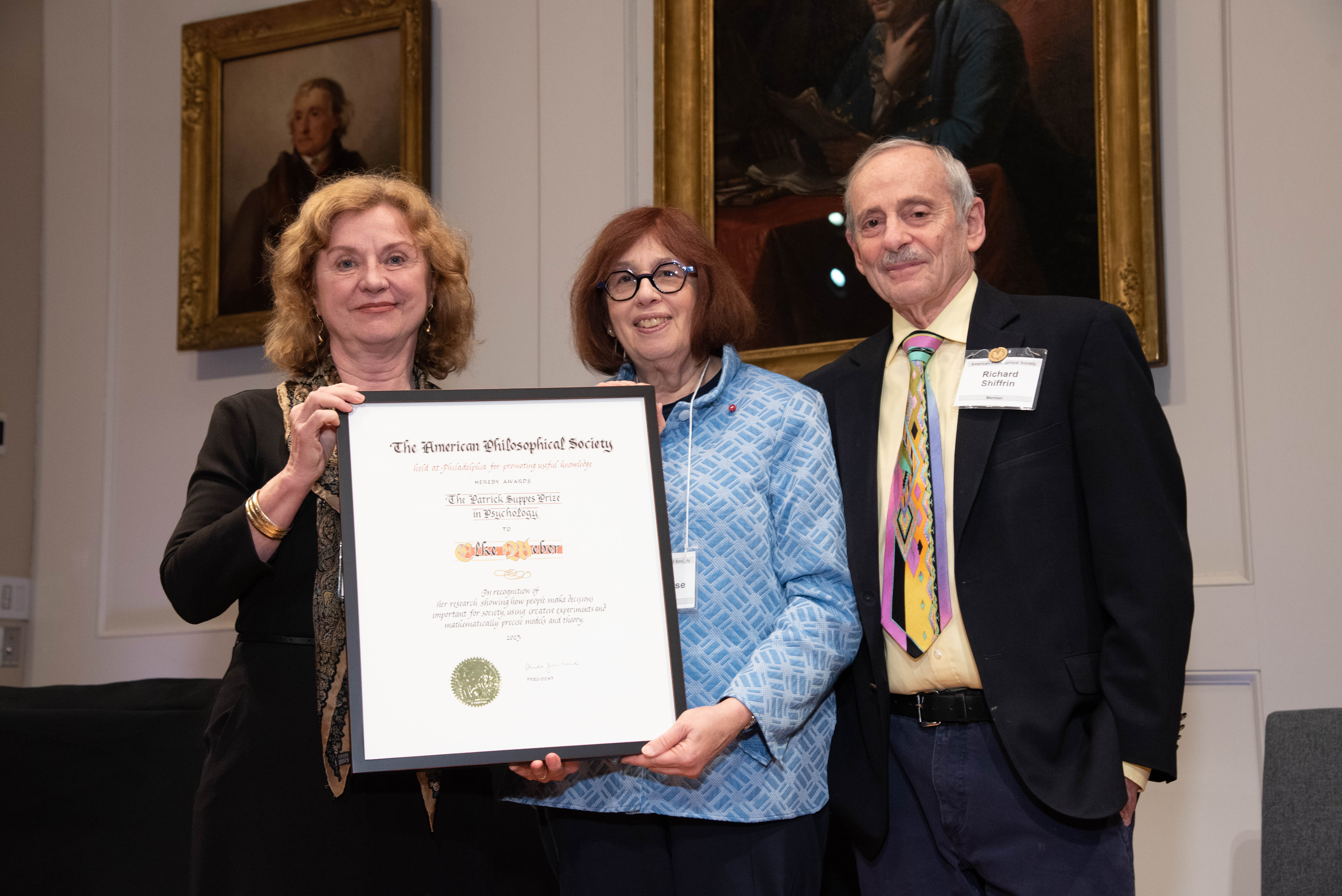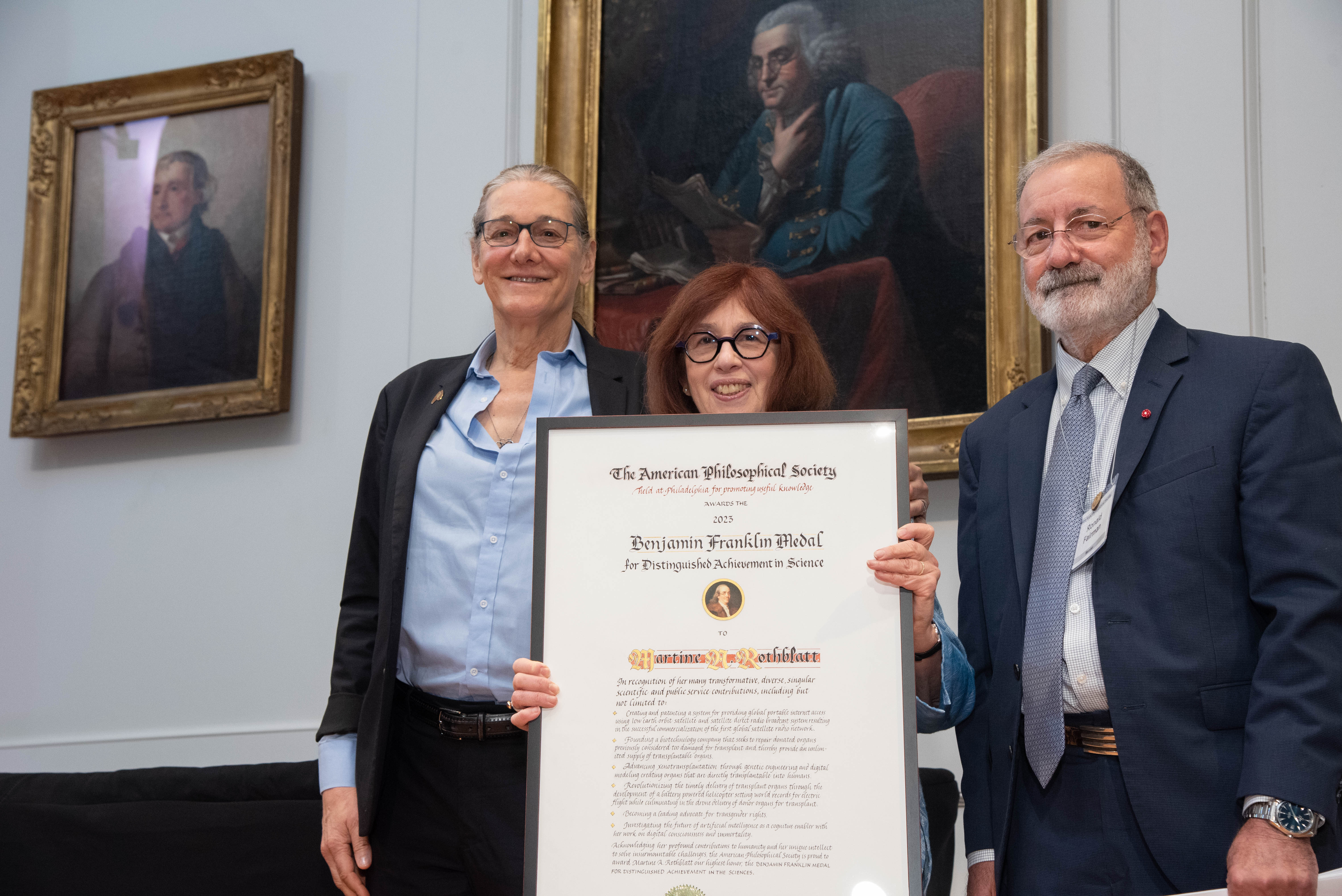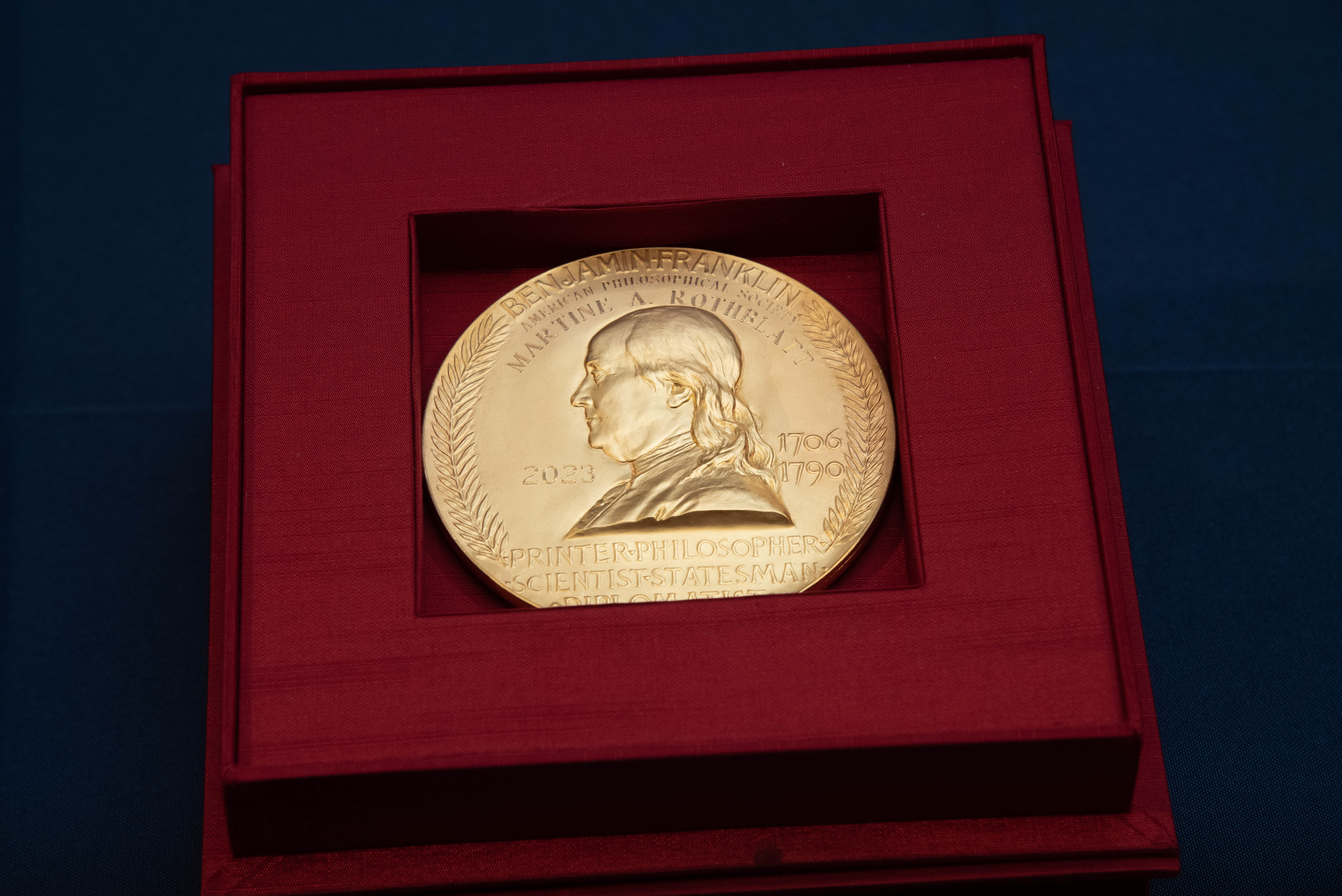December 2021
Philip Kitcher (APS 2018) has been awarded the Carl Gustav Hempel Award for 2020 from the Philosophy of Science Association. Additionally he has published two books this year: Moral Progress and The Main Enterprise of the World: Rethinking Education.
Claire L. Parkinson (APS 2010) was inducted into the Maryland Women’s Hall of Fame and received NASA’s Distinguished Service Medal, the highest recognition awarded by NASA to its employees.
APS Member Robert Jervis (APS 2014), the Adlai E. Stevenson professor of international politics, passed away from lung cancer complications in his home on Dec. 9, 2021. He was 81 years old.
APS Member Michael E. Fisher (APS 1993) died on November 26, 2021, in Silver Springs, MD, at the age of 90.
November 2021
The Carnegie Corporation of New York has named Louise Richardson (APS 2017), currently the vice chancellor of Oxford University, as its next president, succeeding Vartan Gregorian who died in April.
Michael Fried (APS 2003), Johns Hopkins Academy professor and professor emeritus of the humanities, gave the Johns Hopkins Academy Lecture titled "All or Nothing: Manet in the 1860s."
Cora Diamond (APS 2007), a distinguished philosopher, received an Honorary Degree of Doctor of Humane Letters from the University of Chicago.
Mark Thompson (APS 2017) and Maria Ressa will co-chair the board of the new initiative, called International Fund for Public Interest Media, beginning Oct. 1.
APS member Frederik Willem de Klerk (APS 1994) died on November 11, 2021, in Cape Town, at the age of 85. As president of South Africa he dismantled the apartheid system that he and his ancestors had helped put in place.
October 2021
Harvard faculty member Danielle Allen (APS 2015) to speak in Viterbo ethics series.
Vinton G. Cerf (APS 2008), vice president and chief internet evangelist for Google, will speak at Hood College.
National Gallery of Art Board of Trustees Elects Indra Nooyi (APS 2021) as New Trustee and David Rubenstein (APS 2019) as Chairman.
Ruth J. Simmons (APS 1997) gave the Washington Post Live lecture Race in America: HBCUs with Ruth J. Simmons, PhD.
Andrea M. Ghez (APS 2012), 2020 Nobel Prize Winner and Astrophysics Expert, Named Honorary Member of Zonta International.
APS member Prof. Dr Jack David Dunitz (APS 1997) died on September 12, 2021, in Switzerland, at the age of 98. He is credited with shaping contemporary structural chemistry and was renowned as a teacher and mentor.
APS member Colin L. Powell (APS 1998) died on October 18, 2021, in Bethesda, Maryland, at the age of 84. He was an American politician, diplomat, and four-star general who served as the 65th United States secretary of state from 2001 to 2005.
APS member Ronald S. Stroud (APS 2005) died on October 7, 2021, in Berkeley, California, at the age of 88. Ron Stroud was one of the world's leading Greek epigraphists.
Marjorie McCarty, a beloved colleague and the widow of Rockefeller’s Maclyn McCarty, has passed away at the age of 94. We have lost a cherished, long-time member of our community.
September 2021
Giorgio Parisi (APS 2013) won the 2021 Nobel Prize in Physics "for the discovery of the interplay of disorder and fluctuations in physical systems from atomic to planetary scales."
Joy Harjo (APS 2021) released her second memoir, entitled Poet Warrior.
The program Sandra Day O'Connor: The First has appeared on PBS, highlighting Sandra Day O'Connor (APS 1992), with commentary by Linda Greenhouse (APS 2001).
Mary Beth Norton (APS 2010) wins 2021 George Washington Prize for “1774: The Long Year of Revolution”
Jeffrey Gordon (APS 2014) is a recipient of this year’s Balzan Prize for his role in founding the field of human gut microbiome research and revolutionizing the understanding of gut microbes and their roles in human health and disease.
Anne-Marie Slaughter (APS 2011) explains what she has learned from a long career of public service in her new book, Renewal: From Crisis to Transformation in Our Lives, Work, and Politics.
Indra Nooyi (APS 2021), former CEO of PepsiCo, narrates her rise to the top in her new book, My Life In Full: Work, Family, and Our Future.
Kara Walker (APS 2018) will be part of a virtual discussion on September 27.
Giorgio Parisi (APS 2013) has been named a Clarivate Citation Laureate.
Pamela Björkman (APS 2002) has been named the recipient of the 2021 Pearl Meister Greengard Prize, a major international award recognizing outstanding women scientists and presented by The Rockefeller University.
Jianguo “Jack” Liu (APS 2015) of Michigan State University, has been honored with the World Sustainability Award for his leadership in integrating the needs of both humans and nature and succeeding in having the work translated into policy and practice.
August 2021
Paul Alivisatos (APS 2015), the incoming president of the University of Chicago, received the Priestley Medal at the American Chemical Society’s annual meeting.
Geoffrey R. Stone (APS 2010) is one of the recipients of this year’s Norman Maclean Faculty Award of the University of Chicago.
APS member Hugo Freund Sonnenschein (APS 2001) died on July 15, 2021, in Chicago, IL, at the age of 80. He was a renowned economist and longtime university administrator who led the University of Chicago through a transformational period as its 11th president.
APS member Ying-shih Yu (APS 2004) died on August 1, 2021, in Princeton, NJ, at the age of 91. He was a historian of China who taught at Harvard, Princeton and Yale Universities; his books were banned by the ruling Communist Party in 2014 after he expressed support for pro-democracy activism.
APS member Gary B. Nash (APS 2000) died on July 29, 2021, in California, at the age of 88. He was a leading UCLA scholar revered for his role in shaping K-12 American history curricula and admired for standing his ground — even in a public entanglement with the wife of a U.S. vice president.
APS member Noel M. Swerdlow (APS 1988) died on July 24, 2021, in California, at the age of 79. Dr. Swerdlow was famous for his approach to studying the works of ancient scientists, which held that modern scholars should be able to understand the mathematics used by ancient writers—from the Babylonians to Kepler. His translations of and commentary on 16th-century astronomer Copernicus, and other astronomers from antiquity to the Renaissance, are foundational texts still read around the world.
July 2021
Jack Szostak (APS 2012) will join the faculty of the University of Chicago as University Professor in the Department of Chemistry and the College.
The American Chemical Society (ACS) has announced that it will honor Peter B. Dervan (APS 2002), Caltech's Bren Professor of Chemistry, Emeritus, with the 2022 Priestley Medal, the society's highest honor.
Paul Alivisatos (APS 2015) has been named the John D. MacArthur Distinguished Service Professor in the Department of Chemistry, the Pritzker School of Molecular Engineering and the College, effective Sept. 1 at the University of Chicago, where he's the incoming President.
Craig Calhoun (APS 2012) joins Melikian Center as interim director.
APS member Purnell W. Choppin (APS 1988) died on July 3, 2021, at home in Washington, DC, at the age of 91. He was a physician, virologist, and scientific administrator who performed pioneering research on viruses at The Rockefeller University and later exerted a powerful influence on biomedical research as president of the Howard Hughes Medical Institute.
APS member Steven Weinberg (APS 1982) died on July 23, 2021, in Austin, TX, at the age of 88. His discoveries deepened understanding of the basic forces at play in the universe, and he took general readers back to its dawn in his book “The First Three Minutes.”
June 2021
Noted researcher and scientific leader Jack E. Dixon (APS 2010) retires. In a career spanning almost half-a-century, Dixon pioneered new discoveries and advanced science at both UC San Diego and the Howard Hughes Medical Institute.
Harvard conferred seven honorary degrees, including to Frances H. Arnold (APS 2018), Arlie R. Hochschild (APS 2021), and Margaret H. Marshall (APS 2017).
Billie Tsien (APS 2017) was appointed by President Biden to the Commission of Fine Arts.
Read Mellon President Elizabeth Alexander’s (APS 2020) feature in the June issue of National Geographic.
Sarah B. Pomeroy (APS 2014), was interviewed by Lynn Sherr about her book, Benjamin Franklin, Swimmer (American Philosophical Society Press 2021)
NBAA present the Meritorious Award to Martine Rothblatt (APS 2008).
Yo-Yo Ma (APS 1999) and long-time musical partner Emanuel Ax (APS 2009) have released Hope Amid Tears on Sony Classical.
Danielle Allen (APS 2015) is running for Governor of Massachusetts.
Jianguo "Jack" Liu (APS 2015) received the Gunnerus Award in Sustainability Science.
Pioneering climate change researcher Warren Washington (APS 2003) receives honorary degree
Veerabhadran Ramanathan (APS 2006) will receive the Blue Planet Prize, the international environmental award sponsored by Japan’s Asahi Glass Foundation.
APS member Lewis Wopert (APS 2002) died on January 28, 2021. A charismatic advocate of his science, Lewis originated the concept of positional information to explain the formation of pattern in the development of an embryo. His work played a central role in building the field.
APS member Jean D. Wilson (APS 2000) died on June 13, 2021, in Dallas, TX, at the age of 88. Dr. Wilson made scientific discoveries that led to effective prostate treatments, insights into sexual differentiation.
May 2021
Stephen Benkovic (APS 2002) was elected a Foreign Member of Royal Society.
Roger Ferguson, Jr. (APS 2016) to deliver Tuck Investiture Address.
Annette Gordon-Reed (APS 2019) to be Dartmouth Class of 2021 Commencement speaker.
Politics and Prose will be hosting lectures by several APS Members
Robert B Pippin (APS 2009) will discuss Philosophy by Other Means. He will be joined in conversation by Jensen Suther.
SCC Justice Rosalie Abella (APS 2018) will serve as Pisar visiting professor at Harvard Law School for three years.
Claire L. Parkinson (APS 2010) receives the 2020 Roger Revelle Medal.
Anthony Fauci (APS 2001) acclaimed infectious disease expert will deliver the 67th Beatty Lecture virtually on Friday, October 1, 2021.
Dr. Jane Goodall (APS 1988) wins 2021 Templeton Prize.
APS member Sally Falk Moore (APS 2005) died on May 2, 2021, in Cambridge, Massachusetts, at the age of 97. Professor Moore was a giant in the fields of legal and political anthropology. She did her major fieldwork in Tanzania and published extensively on cross-cultural, comparative legal theory.
APS member Marye Anne Fox (APS 1996) died on May 9, 2021, in Austin, Texas, at the age of 73. She was a tough-minded chemist who guided UC San Diego through eight often difficult years of growth as the school’s chancellor and was awarded the National Medal of Science for her insights about sustainable energy.
April 2021
Regna Darnell (APS 2004) has won two awards and has three publications coming out:
- She won the 2020 Lifetime Service Award from the Women’s Caucus, Canadian Anthropology Society
- She won the 2020 Lifetime Achievement Award from the American Society for Ethnohistory
- She published History of Anthropology: A Critical Window on the Discipline in North America (2021)
- She will publish Method and Theory in the History of Anthropology (2022)
- She edited the forthcoming Franz Boas Papers: Documentary Edition
Annette Gordon-Reed (APS 2019) will soon publish On Juneteenth.
Henry Louis Gates Jr. (APS 1995) was named Don M. Randel Award recipient at the American Academy of Arts & Sciences.
Roger W. Ferguson Jr. (APS 2016) will join the Council on Foreign Relations as the Steven A. Tananbaum Distinguished Fellow for International Economics starting on May 10, 2021.
Jeffrey Gordon (APS 2014) has been awarded the 2021 Kober Medal, in recognition of his outstanding contributions to the field of gut microbiome research.
Laurence Tribe (APS 2010) named to Presidential Commission on the Supreme Court.
Judith Butler (APS 2007) will be giving the lecture "Debt, Guilt, Responsibility, Obligation."
Retired Mass. Supreme Judicial Court Chief Justice Margaret H. Marshall (APS 2017) to receive 2021 Bolch Prize.
Ruth J. Simmons (APS 1997) will speak at Princeton’s Baccalaureate ceremony.
Benjamin Isaac (APS 2003) has published Empire and Ideology in the Graeco-Roman World.
Steven Weinberg (APS 1982) and Simon Levin (APS 2003) will be presenters at the University of Texas at Arlington’s College of Science's Science Week.
Rosalie Silberman Abella (APS 2018), justice of the Supreme Court of Canada, will serve as Pisar visiting professor of law at Harvard Law School, effective July 1, 2022 for a three-year term.
APS Member Robert L. Herbert (APS 1993) died on December 17, 2020, in Northampton, MA, at the age of 91. He was a pioneering scholar of 19th-century art whose 1988 history of Impressionism, viewed through a social lens, delivered a robust transfusion to the study of that period.
APS Member Vartan Gregorian (APS 1985) died on April 16, 2021, in Manhattan, at the age of 87. He was best known for resurrecting the New York Public Library from a fiscal and morale crisis in the 1980s.
APS Member Charles M. Geschke (APS 2012) died on April 16, 2021, in Los Altos, California, at the age of 81. He was a computer scientist who teamed up with John Warnock (APS 2009) at Xerox and formed Adobe, a firm that rendered traditional printing equipment obsolete.
APS Member David Wake (APS 1996) died on April 29, 2021, in Berkeley, California, at the age of 84. He was one of the world’s leading experts on salamanders and among the first to warn of a precipitous decline in frog, salamander and other amphibian populations worldwide.
March 2021
Steven Weinberg (APS 1982) will be participating in the Harvard Science Book Talk: "an Evening with Steven Weinberg, in conversation with Andrew Strominger"
Gordon Baym (APS 2000) will be giving the talk "Neutron stars & matter under extreme conditions: from Copenhagen to the Golden Age"
Elaine Fuchs (APS 2005) will be giving the talk "Stem Cells: It’s All about the Environment"
Lawrence Bobo (APS 2008), Henry Louis Gates, Jr. (APS 1995), and Claude Steele (APS 2008) will be webcasting "America's Black-White Divide: Looking Back, Looking Around, Looking Forward" in conversation with Margaret Levi (APS 2018).
Martha C. Nussbaum (APS 1995) has won the 2021 Holberg Prize for her groundbreaking contribution to research in philosophy, law and related fields.
Justice Goodwin Liu (APS 2020) will be chairing a workshop entitled "The Science of Implicit Bias: Implications for Law and Policy".
Margaret Murnane (APS 2015) has been awarded the 2021 Benjamin Franklin Medal in Physics.
Kathryn Sikkink (APS 2013) will be inducted as a Fellow of the American Academy of Political Science (AAPSS) in 2021.
Yale Chief Executive Leadership Institute Presents Anthony Fauci (APS 2001) with the Legend in Leadership Award.
Susan Neiman (APS 2018) will be giving the talk "Conversations on Europe. Learning from Memory: A Transatlantic Conversation with Susan Neiman and Michael Rothberg."
Walter Isaacson (APS 2005) will be giving the talk "A Conversation with Jennifer Doudna & Walter Isaacson."
Stuart H. Orkin (APS 2017) has been awarded the 2021 Gruber Genetics Prize, for pioneering our understanding of the development of blood cells (hematopoiesis) and the genetic underpinnings of both rare and common blood cell disorders.
Olufunmilayo I. Olopade (APS 2011) will be giving the lecture "What African Genomes Tell Us About the Origins of Breast Cancer" at the STAGE International Speaker Seminar Series.
The Harvard Gazette published a memorial tribute to the late Sidney Verba (APS 2003).
The 2021 Wolf prize in Medicine was awarded to Joan Steitz (APS 1992) for ground-breaking discoveries on RNA processing and its function.
The 2021 Wolf prize in Physics is awarded to Giorgio Parisi (APS 2013) for ground-breaking discoveries in disordered systems, particle physics and statistical physics.
Twyla Tharp (APS 2015) biography on American Masters premieres March 26.
APS Member Alexander Spirin (APS 1997), Director Emeritus of the Institute of Protein Research, Russian Academy of Sciences, died December 30.
APS Member Robert Middlekauff (APS 1997), Preston Hotchkis Professor of American History Emeritus at the University of California, Berkeley, died March 10.
APS Member George F. Bass (APS 1989), pioneering underwater archaeologist and Texas A&M Distinguished Professor Emeritus, died Tuesday March 2 in Bryan, Texas, at 88.
February 2021
Anthony Fauci (APS 2001) has won the $1 million Dan David Prize for “defending science” and advocating for vaccines now being administered worldwide to fight the coronavirus pandemic.
Carl June (APS 2020) has won a "future" Dan David Prize for Molecular Medicine.
Corning Incorporated today appointed Roger W. Ferguson Jr. (APS 2016), president and chief executive officer of TIAA, to Corning’s Board of Directors, effective April 1, 2021.
Henry Louis Gates, Jr. (APS 1995) has recently published The Black Church: This Is Our Story, This Is Our Song.
Sean B. Carroll (APS 2017), a world-renowned evolutionary biologist whose discoveries have shed light on the evolution of animal diversity, will deliver the 2021 Darwin Day Lecture at Vanderbilt University.
Joanna Aizenberg (APS 2016) will be giving the lecture "New Bio-inspired Materials: When Chemistry Meets Optics, Mechanics and Surface Science"
Katherine Sikkink (APS 2013) will give a lecture on her book The Hidden Face of Rights: Towards a Politics of Responsibilities.
Anthony Fauci (APS 2001) was named recipient of the 2021 Ivan Allen Jr. Prize for Social Courage. An annual award from the Georgia Institute of Technology, the Ivan Allen Jr. prize honors individuals who have stood up for moral principles at the risk of their careers and livelihoods.
Judge David S. Tatel (APS 2007) has notified President Biden that he will assume senior status effective upon the appointment of his successor. He has served on the U.S. Court of Appeals for the District of Columbia Circuit for 27 years and looks forward to serving many more as a senior judge.
APS Member Paul J. Crutzen (APS 2007) died on January 28, 2021, in Mainz, Germany, at the age of 87. He was a Nobel-winning chemist who revealed threats to the ozone layer, developed the concept of “nuclear winter” and concluded that humans were having such a profound impact on the planet that it was time to recognize a new geological epoch.
APS member George P. Shultz (APS 1992) died on February 6, 2021, in Stanford, CA, at the age of 100. He carried one of Washington’s weightiest résumés — labor secretary, treasury secretary and budget director for Nixon and secretary of state under Reagan as the Cold War waned. He won the Medal of Freedom in 1989.
APS member J. Hillis Miller (APS 2004) died on February 9, 2021, in Sedgwick, Maine, at the age of 92. He was a massively influential literary critic and theorist.
APS Member I. M. Singer (APS 1985) died on February 11, 2021, in Boxborough, MA, at the age of 96. Dr. Singer created a bridge between two seemingly unrelated areas of mathematics and then used it to build a further bridge into theoretical physics. He won the National Medal of Science in 1983 and the Abel Prize in 2004.
APS member William B. Eagleson, Jr. (APS 1977) died on February 5, 2021, in Lafayette Hill, PA, at the age of 95. He was former chairman of Girard Bank, Philadelphia, and chairman emeritus of Mellon Bank Corp.
January 2021
Meave Leaky (APS 2017) has a new book out, entitled The Sediments of Time.
Louise Richardson (APS 2017) will be part of the Irish Embassy's 2021 St Brigid’s Day Festival.
Anthony Fauci (APS 2001) was named recipient of the National Academy of Sciences Public Welfare Medal. The Public Welfare Medal is the Academy’s most prestigious award and was presented to him for his "decades-long leadership in combatting emerging infectious diseases, from the AIDS crisis to the COVID-19 pandemic, and being a clear, consistent, and trusted voice in public health."
Theda Skocpol (APS 2006) will be speaking at an event entitled "The Next Four Years: what should we expect for America?"
Georgia Tech to Award Anthony S. Fauci (APS 2001) the 2021 Ivan Allen Jr. Prize for Social Courage.
Anthony Fauci (APS 2001) was awarded the 2020 Harris Dean's Award.
Eric Foner (APS 2018) will deliver the opening Foley Distinguished Lecture, “The crisis in historical context: What the era of Reconstruction tells us,” on Feb. 16.
Sir Angus Deaton (APS 2014), Nobel Prize winning economist and co-author of Deaths of Despair and the Future of Capitalism, joins the CFA Society for its February Distinguished Speaker Series webinar to discuss his book, address the challenges threatening large parts of middle America, and offer solutions that can alter the current system to one that may work for all.
Jane Goodall (APS 1988) will be speaking at the Salesforce Nonprofit Summit.
Teodolinda Barolini (APS 2002) will unveil Dante's views of “others” in the Divina Commedia and ponder on sexuality issues - his views on women and homosexuality, as well as his attitude towards non-Christians - at an event put on by the Embassy of Italy and the Italian Cultural Institute in Washington, DC.
APS member Giles Constable (APS 1987) died on January 18, 2021, in Princeton, NJ, at the age of 92. He was a vigorous explorer of medieval religious and intellectual history whose expansive work has provided new and authoritative perspectives on the Middle Ages.
APS member Lionel Gossman (APS 1996) died on January 11, 2021, in Philadelphia, at the age of 91. He was a specialist in French literature and history and "one of the great humanists and scholar-teachers of his generation."
APS member Shirley S. Abrahamson (APS 1998) died on December 19, 2020, in Berkeley, CA, at the age of 87. She was the first woman to serve on the Wisconsin Supreme Court and its first female Chief Justice.
APS member Leo A. Goodman (APS 1976) died on December 22, 2020, in California, at the age of 92. He was considered a “giant in his field” of statistics and sociology.
The following Members were found to have passed at an earlier date in our annual membership check:
APS member Larissa Adler Lomnitz (APS 2011) died on April 19, 2019, in Mexico, at the age of 87. Since the publication of her book Como sobreviven los marginados in 1975, she became known worldwide. Her numerous anthropological studies have long been important references for social science research.
APS member Robert McCredie May (APS 2001) died on April 28, 2020, in the UK, at the age of 84. As chief scientific adviser to the UK government from 1995 to 2000, he shook up the cozy relationship between politicians and the scientific community, and made both think about the public they served.
APS member Jean-Louis Ferrary (APS 2019) died on August 9, 2020, in France, at the age of 72. Jean-Louis Ferrary was interested in the history of institutions, law and the laws of ancient Rome, in the history of ideas and ancient political philosophy, in Greek and Latin epigraphy of Roman times, Latin philology and historiography.
APS member Jacques Mehler (APS 2009) died on February 11, 2020, in France, at the age of 84. Jacques Mehler became one of the founders of twentieth-century psycholinguistics, having gained one of the earliest Ph.D.s in the subject at Harvard in 1964.
APS member Michael J. Berridge (APS 2007) died on February 13, 2020, in the UK, at the age of 81. Sir Michael’s work on cell signaling and the landmark discovery of the key role that calcium plays in controlling cellular activity led ultimately to important insights into the physiology of conditions as diverse as cancer, bipolar disorder, cardiovascular and neurological diseases.
APS member Louis Nirenberg (APS 1987) died on January 26, 2020, in New York City, at the age of 95. He was a mathematician who explored the complexities of equations commonly used by physicists and engineers and shared the 2015 Abel Prize for doing so.
